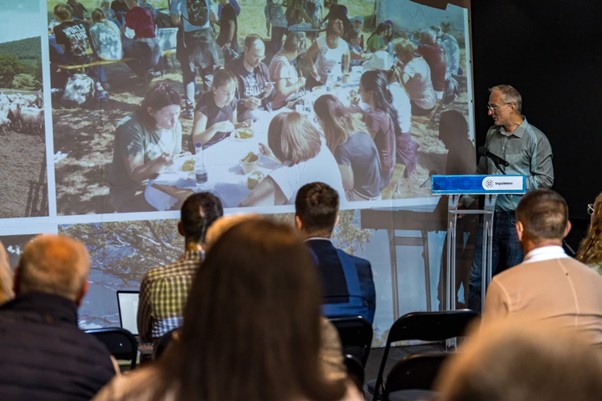Sfântu Gheorghe / Sepsiszentgyörgy, 16 July 2025 – In a dynamic and forward-looking event organized by the Partnership Meeting of the Active Tourism Development Strategy of Historical Sepsiszék, our team member Tibor Hartel presented key insights from recent DBU-funded research on biocultural tourism and rural resilience. The event brought together local stakeholders, policymakers, researchers, and community members to explore innovative ways of revitalizing traditional rural landscapes through responsible tourism and heritage-based development.
Hartel emphasized that biocultural landscapes, where natural and cultural values co-evolve, are among Europe’s most important yet undervalued social-ecological systems. Romania alone holds over 5 million hectares of High Nature Value (HNV) farmland – rich in biodiversity, memory, and traditional practices. However, the communities that maintain these systems are too often sidelined in conservation and tourism planning. He argued that biocultural tourism offers a new paradigm: one that unites environmental stewardship with meaningful visitor engagement and community well-being. More than just eco-tourism, this model relies on authentic, emotionally engaging experiences where guests can connect with both nature and the living heritage of local people.
The presentation was structured around five psychological factors that shape people’s willingness to engage in biocultural tourism: attitude, relational values, trust in authenticity, perceived contribution to community and nature, and perceived behavioural control (logistics, access, time). The research he presented showed that awareness alone doesn’t predict intention. Deep emotional and value-based connection is key.
The DBU funded wood-pasture project revealed that orchards, forests, pastures, and churches are interlinked through emotional, cognitive, and experiential values. These elements form the “living core” of biocultural systems, networks of meaning as much as matter.
Taken together, these insights highlight the need to rethink tourism as a co-creative practice—not just consumption, but connection.
In his closing message, Hartel stressed that places like Sepsiszék, home to ancient wood-pastures and rich cultural traditions, can become models for value-based tourism if grounded in authenticity, local participation, and shared stewardship.
Photo: Sepsi Metropoliszövezet – Zona Metropolitană Sepsi

